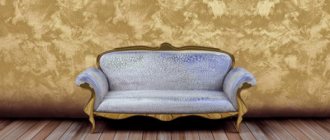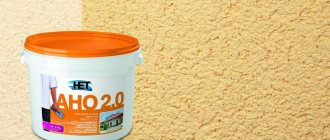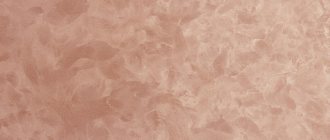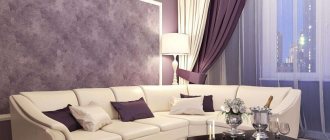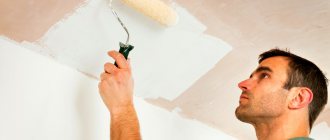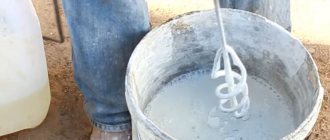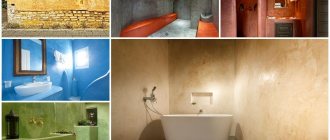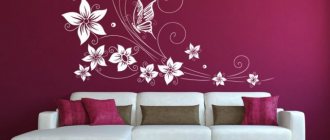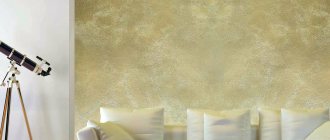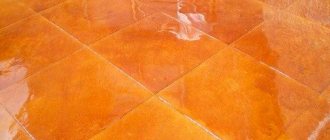Volna plaster rightfully occupies a leading position among decorative finishes due to its ease of application and high aesthetic and performance indicators.
Can be used for interior design and facade decoration.
With its help, you can create decorative effects of a light sea breeze or huge raging waves on the surface of the walls.
Features of the material
The range of domestic finishing materials "Volma" is quite rich: there are no fewer products on store shelves than products from famous foreign brands. Many craftsmen call the brand the “answer” to the German “Rotband”, which costs an order of magnitude more. Among the Volma product line you can find plaster for any type of work: there are rough leveling, finishing and even decorative materials.
The composition of the plasters includes only environmentally friendly components that are safe for humans and the environment. Among them, the main share is occupied by mineral substances, but there are also modern synthetic ingredients, as well as fillers and binders. Some plasters can only be applied by hand, others are designed for machine application.
Types of plaster
All types of plaster of this brand can be divided according to the main component, which forms the base of the building mixture:
- gypsum - contain gypsum, with some exceptions they are recommended only for interior work;
- cement - ideal for all types of work, considered universal.
Depending on the purpose, all plasters can be divided into those that are suitable for rough (preparatory and leveling) work, for maintaining the microclimate in the room, for increasing the strength of surfaces, etc.
Here are examples of the range of Volma brand products:
- "Layer". A gypsum mixture based on a light binder with the addition of chemical components to increase adhesion and optimize water-holding capacity.
- "Titanium Layer". High-strength gypsum plaster with increased adhesion to surfaces.
- "Layer Ultra". A material that does not require putty, based on gypsum.
- "Canvas". Dry lightweight mixture for manual application with mineral and synthetic additives.
- "Plast". A special material for easy leveling of walls and ceilings, plastic, can be used for decorative finishing.
- "Lux". Super lightweight thin-layer plaster for aerated concrete, also suitable for foam concrete.
- "Start". A starting gypsum material suitable for walls and ceilings inside heated rooms with normal humidity.
- "Title". Gypsum material for finishing work that does not require subsequent puttying.
- "Gloss". Material applied for subsequent finishing putty.
- "Aqualite". Dry plaster mixture for finishing rooms with high humidity, suitable for application under tiles.
- "Aqualayer". Cement leveling material with modern polymer and mineral additives and modifiers.
- "Bark beetle" and "Fur coat". Decorative plasters to create a unique texture contain white Portland cement, microfiber, modifiers and fractional stone chips.
- "Case". High strength cement plaster. Designed for finishing the base and carrying out other external work.
- "Gypsum asset". Mixture for professional machine application. It has a variety - “Gypsum Active Extra” with increased resistance to cracking.
- "Tandem". A universal mixture that can serve as plaster and putty.
Wave - decorative plaster
The composition has a number of advantages:
- is resistant to the negative effects of high humidity;
- plaster tolerates the effects of ultraviolet radiation;
- the material is immune to aggressive salts contained in sea air.
This means that the mixture can be used in buildings on the sea coast, where this finishing effect makes the corresponding atmosphere more pronounced. In addition, the material was developed for operation under such conditions (near bodies of water). As a result, it became possible to carry out original design not only of the internal surfaces of buildings, but also of the facades.
Using Volna plaster, you can create a semblance of a raging sea (large curves) or calm, light “lambs” that run ashore when there is calm.
Scope of application
Volma brand building compositions can be selected for any situation. The range includes products for rooms with different types of humidity, including bathrooms, showers, kitchens, saunas and swimming pools. "Volma" is suitable for application on all types of building bases - brick, concrete, aerated concrete, gypsum plasterboard, foam concrete, chipboard, OSB, cement-lime coatings.
Plaster can be used to decorate different rooms, applied to walls, ceilings, partitions, niches, arches. Many products are suitable for facade work, cladding plinths, and unheated buildings.
Wave plaster deck application technology
The first step is to prepare the surface. The good news is that you don’t need to bring the wall to a perfectly level state. Decorative plaster wave can hide minor defects. The surface itself must be dry, free of dirt, grease and dust. It should also be durable so that nothing falls off during or after work.
Don’t forget to use a deep penetration primer, which will help even out the absorbency of the surface. This will also help you not to worry about the formation of mold and fungi in the future. Please note that the primer can take up to 90 hours to dry. You may need to apply a covering primer, which will take a couple of hours to dry.
You need to work at air temperatures from +5⁰С to +35⁰С. Humidity is not particularly important. Before work, you can use colorants to change the color of decorative plaster. Or you can paint the surface when it is dry. In any case, initially the entire mass of the “wave” solution should be mixed using a drill, and only then proceed to application.
Applying wave decorative plaster with your own hands is very easy. You may have to do a little tricking at first. Using a spatula, apply a small amount of solution to the trowel. Then, using a Venetian trowel, we spread the material on the wall in a layer of 1-2 mm. The entire wall is processed. Until the solution dries, we use a trowel to create a figured pattern. If you work too slowly, then by the time you apply decorative plaster to the entire wall, it will begin to dry out. After this, the formed pattern can no longer be corrected. When the drawing is formed, we leave everything to dry for 2-3 days.
After the specified time, we begin applying the finishing coat. To do this, apply the glazing mother-of-pearl composition to the wall using a fur roller. Here we will need a bowl into which our coating is poured. This makes it easier to work with a roller. Apply the finishing coat evenly over the entire wall. We process the entire surface at once without rest, otherwise joints will be formed.
Now the foam sponge comes into play. Rub the layer you just applied with it, not letting it dry. In 2-3 hours everything will dry. To better reveal the design, white wallpaper paint is applied to a dry surface with a velor roller. The main thing is to remove excess paint from the tool in advance. To do this, you can roll the roller over some piece of plywood, where the excess paint will remain. After that we paint the wall itself. Remember, we only need to paint the raised areas, so we lightly touch the surface with the roller. Pressing too hard will only cause damage. The unevenness of color will highlight the relief. The paint will take one day to dry. The surface is ready, and the decorative plaster used helped shape the pattern.
Specifications
Volma plasters may differ from each other in technical parameters, which depends on the components included in the composition. There are also average characteristics. Thus, the time until most mixtures dry completely is 5-7 days, and the recommended temperature for working with them is +5...+30 degrees. After hardening, the plaster layer tolerates temperature changes within the range of –40…+60 degrees. The initial setting time of the layer is 20-40 minutes, the final setting occurs in 180 minutes.
Compound
Volma plasters are made on a cement or gypsum base. Also, to increase strength, stickiness and other positive properties, stabilizers, modifiers, plasticizers, frost-resistant additives, anti-caking agents, etc. are introduced into the composition of materials.
Shades
The mixtures are presented in gray, beige, light yellow versions. They are usually used to level various surfaces. Those Volma plasters that are intended for finishing are sold in white. White mixtures can be tinted with dry pigments, but this is only required for decorative plasters. If desired, after drying, they can be painted with any silicate, silicone, or acrylic paints.
Layer thickness
The recommended layer thickness when working with these types of building materials is 5-30 mm. The permissible thickness of the plaster layer is 6 cm, but only with preliminary reinforcement. The minimum layer that can be applied is limited by the grain size of the filler, and in its absence - by 3 mm.
Adhesion and strength
All Volma plasters are characterized by a high degree of adhesion to building materials. Their compressive strength is 3.5 MPa, and their flexural strength is 1.5 MPa.
Frost resistance and water absorption
Thanks to the presence of special additives that increase resistance to low temperatures, some plasters can withstand up to 75-100 freezing and thawing cycles. Most of them tolerate temperature drops down to –40 degrees, and some mixtures (for example, “Bark beetle”) - down to –50 degrees. All compositions are characterized by a low degree of water absorption.
Material characteristics
Decorative plaster has an impressive list of advantages:
- as noted above, the coating is resistant to chemical and mechanical influences;
- the material is universal, there are practically no restrictions on its use;
- due to the high elasticity of the mixture, any pattern can be formed;
- It is worth noting the relatively low consumption: 0.8 – 2 kg/m², which means the material is economical;
- the composition of the plaster mixture is environmentally friendly: it does not contain harmful impurities, no pungent odor, and when dried, a vapor-permeable coating is obtained;
- the application technology does not require perfect preliminary alignment of the walls;
- With the proper patience and skill, wave decorative plaster can be applied with your own hands.
With so many undeniable advantages, the coating has a number of disadvantages:
- work on complex reliefs will significantly increase the cost of finishing work;
- dismantling a decorative plaster coating is a labor-intensive process, after which you will have to restore the wall surface;
- You need to work quickly with the mixture applied to the wall, since after drying the coating cannot be adjusted.
Tips for using plaster
When working with plaster mixtures, it is necessary to ensure optimal environmental conditions (temperature within +5...+30 degrees, humidity not higher than 80%). If the humidity in the room is too high, the plaster layer will swell or peel off. You cannot treat walls if they are frozen - you will have to wait until the temperature rises outside or indoors.
The solution is diluted in small portions, because after 20 minutes the top layer of gypsum in the container begins to set, and you need to have time to apply the mixture to the surface. The substrate is prepared carefully, since poor quality of the base reduces the adhesion of the plaster. Before painting plaster walls or wallpapering, it is important to make sure that the plaster is completely dry.
Preparation of the solution
The exact proportions of the dry mixture and water are always indicated on the plaster packaging. On average, 1 kg of powder mass requires 0.6 liters of clean, cool water. First, a measured volume of liquid is poured into a plastic container, then the powder is gradually poured in, thoroughly mixing the product using a construction mixer.
Before applying to the walls, the plaster should have the consistency of sour cream, without lumps or foreign inclusions. If the mixture spreads, it means it is not prepared correctly and there is too much water in it.
Surface preparation
Before plastering begins, prepare the base - a wall, ceiling or other area. It is cleaned of the old coating, flaking, crumbling pieces of paint and putty are completely removed. Dirt, grease and oil stains are wiped off with a solvent. Metal parts are treated with anti-corrosion compounds, otherwise they will quickly rust under a layer of plaster. In addition, the following are taken as preparation measures:
- clean the walls from traces of mold and mildew, treat the entire surface with an antiseptic (this is especially important if the work is carried out in a damp room);
- remove traces of efflorescence (salt deposits);
- large depressions are covered with cement mixture, cracks are opened and also coated;
- apply 1-2 layers of primer (only Volma Layer does not require preliminary priming, as indicated on the packaging).
As a primer, it is better to use compositions that are produced by the same Volma-Contact for highly absorbent substrates, based on acrylic dispersion and mineral additives. You can also use the Volma-Interior primer, which is suitable for preparing surfaces for painting and applying decorative plasters.
Tools for work
Volma gypsum plaster is applied using standard construction tools that are suitable for working with any mixture. For manual plastering you will need:
- spatula, trowel, trowel or trowel for applying the product to the wall;
- “H” shaped rule for leveling the plaster layer;
- a wide spatula or a trapezoidal rule for cutting the mortar;
- construction foam plastic grater, polyurethane for mashing the composition;
- large metal spatula for glossing;
- metal scissors and beacons for leveling walls using beacon technology;
- level for determining plane deviations.
Consumables may include fiberglass mesh, rags, and masking tape for protective gluing of various surfaces.
Test application
At the very beginning of work, craftsmen advise diluting a small amount of the mixture for a test application. This will help determine the exact setting time of the composition, its consumption for a certain area, and the labor costs for leveling. The layer thickness is also set at this stage in order to later comply with this indicator.
Sequence of operations
Surface treatment with gypsum or cement plasters of the Volma brand is carried out as follows:
- Leveling the base. Throw the mortar onto the wall using a trowel or trowel. Level the plaster layer using the rule, moving it from top to bottom between pre-installed beacons. Excess mortar is removed and removed, and any recesses that appear are filled with it.
- Trimming. After about 40-60 minutes, when the plaster has set, small roughnesses are smoothed over with the rule. If you plan to decorate the walls with tiles, further steps are skipped.
- Smoothing. Immediately after cutting the mortar, spray the wall with water and rub it with a construction float until “milk” appears on the surface. Even the smallest roughness is thoroughly polished and pores are smoothed out.
- Glazing. A wet metal float is used to process the surface to make it perfectly smooth.
- Padding. If you plan to paint the wall, apply a layer of suitable primer to the plaster.
What does the mixture consist of and what is needed to apply it?
Volna is a decorative plaster made from acrylic and latex with the addition of fillers from marble, granite or quartz flour, cellulose, thickeners and plasticizers.
To give decorative effects, decorative sparkles, mother-of-pearl, gold, bronze, silver powder, and various pigments can be added to the mixture.
Ready-to-use mixtures are supplied in plastic containers.
For interior work, a mixture for interior decoration is purchased. For the decoration of facades - granite or marble plaster mixture for exterior work.
Before starting work, you should stock up on the following tools:
- paint tray;
- a set of steel spatulas;
- structural rollers and stencils;
- stainless steel trowel;
- foam sponges.
To mix the solution, you need a drill with an attachment or a construction mixer.
Material consumption
To calculate the exact consumption, you will have to take into account many different factors - the type of plaster, the thickness of the layer, the degree of curvature of the surface, the type of base material, the technique of applying the composition. This can be done using online calculators, although it is easier to look at the approximate consumption on the packaging of the building mixture and buy the material with a small margin.
Examples of consumption of Volma plasters per layer 1 cm thick, depending on the specific type, are as follows:
- “Layer” - 8-9 kg/sq. m;
- "Plast" - 10 kg/sq. m;
- "Canvas" - 9-10 kg/sq. m;
- “Socle” - 15 kg/sq. m.
Wave plaster, price and cost of work
It is difficult to talk about the cost of materials and work, because everything depends on the skills of the craftsman and the specific region of the country. And the price of materials and services is constantly rising. However, you can emphasize for yourself the average proportion. Typically, the cost of work is approximately one and a half times more expensive than the cost of the material. For example, at the moment the fee for treating a wave of plaster is 1 sq.m. you will need to pay about 1 thousand rubles. At the same time, the material itself will cost about 400 rubles, and 600 rubles will cost the work of a master. We hope that after this article you will not need the services of a specialist, and you will be able to save at least on this.
Advantages and disadvantages
The advantages of Volma building mixtures include:
- frost resistance, resistance to temperature changes;
- high degree of adhesion with most materials;
- environmental cleanliness;
- low consumption;
- ease of application and subsequent operation;
- optimization of the microclimate in the house;
- obtaining a flat, smooth surface;
- plasticity, elasticity of the material;
- absence of shrinkage of the plaster layer, its cracking and detachment;
- preventing the development of fungus and bacteria;
- affordable price and high quality.
The only downside is that sometimes plaster packages may contain large mineral particles that can ruin the finishing layer if they are not removed. Some types of plaster are a little more expensive than other domestic analogues, although they are better in price compared to foreign brands.
Textures created by relief rollers
Stores for decorators have a wide range of textured rollers and stamps for decoration, and various shaped spatulas. The packaging displays the pattern created by the tool, as well as the technology for applying it. You can find a large number of lessons on creating similar rollers from scrap materials. Among such rollers you can find a pattern of waves.
The texture may be different, but the roller must be rolled carefully, pressing firmly against the surface of the freshly applied plaster. For greater clarity of the drawing, it is recommended to wet the roller with water each time. The direction of movement determines the desired effect.
The main thing when working with embossed rollers is that you will have to withstand the same pressure while decorating the entire room; you should also avoid overlapping and diverging stripes.
Correct minor irregularities and defects with a sponge, brush or hand until the plaster has set.
Conditions and shelf life
Packs of dry plaster should be stored only in dry rooms where contact with moisture is prevented, placing them on durable wooden pallets. It is advisable to immediately use packaging whose integrity has been compromised. You can also pour the mixture into a strong bag and tie it tightly. The shelf life of Volma plaster is 12 months.
Despite the huge selection of construction and finishing materials on the modern market, many choose the Volma brand, since it has long earned the respect of professionals. The products from this company are high-quality and wear-resistant, so it is quite reasonable to give your preference to them.

